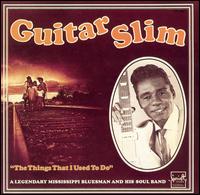The Things That I Used to Do
| "The Things That I Used to Do" | ||||
|---|---|---|---|---|
 | ||||
| Single by Guitar Slim | ||||
| B-side | "Well, I Done Got Over It" | |||
| Released | 1953 (1953) | |||
| Recorded | 1953 | |||
| Studio | Matassa's J&M Studio, New Orleans | |||
| Genre |
| |||
| Length | 2:57 | |||
| Label | Specialty | |||
| Songwriter(s) | Eddie Jones a.k.a. Guitar Slim | |||
| Producer(s) | Ray Charles | |||
| Guitar Slim singles chronology | ||||
| ||||
| Audio sample | ||||
| ||||
"The Things That I Used to Do" is a blues standard written by Guitar Slim. He recorded it in New Orleans, where the young Ray Charles arranged and produced the session. Specialty Records released the song as a single in 1953 and it became a bestseller the following year. Specialty founder Art Rupe believed that the appeal would be limited to the Southern U.S. rural audience. However, urban rhythm and blues radio stations in the North began airing the song and built it into a national hit. As a result, Guitar Slim became in great demand as a performer and played at venues such as the Apollo Theater in New York City.
The single was one of the biggest hits in Specialty's history and stayed on the Billboard's Rhythm and Blues Records charts for 42 weeks. The song remained at number one for six weeks and was the best-selling R&B record of the year, selling more than a million copies.[1]
Composition and recording
Charles' arrangement and piano accompaniment emphasize the religious tone of intense but philosophical regret in the singer's voice, giving the song a gospel-influenced feel. Like Fats Domino, Guitar Slim had a voice with a less adult sound than that of the typical blues shouters of the time, and his lyrics are less explicitly sexual.[2]
Influence and recognition
The Rock and Roll Hall of Fame included the tune on its list of the "500 Songs That Shaped Rock and Roll".[3] Stylistically, the song also contributed to the development of soul music.[4] In addition, the song was a success, thus influencing rock and roll by demonstrating the commercial success of using content that appeals to white listeners and by the effectiveness of its gospel feel.[2] The song had a major impact on the "electric sound" of rock music and featured distorted overtones on the electric guitar a full decade before Jimi Hendrix.[1] Guitar Slim was a favorite of Hendrix, who recorded an impromptu version with guitarist Johnny Winter on slide guitar in 1969.[5] It was officially released on the compilation Both Sides of the Sky (2018).[5]
"The Things That I Used to Do" became a standard as a result of Guitar Slim's distinctive guitar figuring and the rising and falling melody.[6] Blues historian Gerard Herzhaft noted that it "remains a classic of the New Orleans blues [which] was covered by Pee Wee Crayton, Tina Turner, Lonnie Brooks, and Joe Turner".[7] In 1964, a version by James Brown cracked the Billboard Hot 100 at number 99 (the magazine's R&B chart was suspended at the time).[8]
References
- ^ a b Aswell, Tom (2010). Louisiana Rocks! The True Genesis of Rock & Roll. Gretna, Louisiana: Pelican Publishing. pp. 61–65. ISBN 978-1589806771.
- ^ a b Gillett, Charlie (1996). The Sound of the City: The Rise of Rock and Roll (2nd ed.). New York City: Da Capo Press. pp. 139–140, 170. ISBN 0-306-80683-5.
- ^ "500 Songs That Shaped Rock and Roll". Rock and Roll Hall of Fame. 1995. Archived from the original on 2007-07-04. Retrieved February 12, 2017.
- ^ Unterberger, Richie (1996). "Louisiana Blues". In Erlewine, Michael (ed.). All Music Guide to the Blues. San Francisco: Miller Freeman Books. pp. 360–361. ISBN 0-87930-424-3.
- ^ a b McDermott, John (2018). Both Sides of the Sky (Album notes). Jimi Hendrix. New York City: Legacy Recordings. pp. 13–14. 19075814192.
- ^ Watrous, Peter (August 19, 1990). "A Young Blues Guitarist Intent on Modernization". New York Times. Retrieved November 5, 2006.
- ^ Herzhaft, Gerard (1992). "Things That I Used to Do". Encyclopedia of the Blues. Fayetteville, Arkansas: University of Arkansas Press. pp. 474–475. ISBN 1-55728-252-8.
- ^ Whitburn, Joel (1988). "James Brown". Top R&B Singles 1942–1988. Menomonee Falls, Wisconsin: Record Research. p. 59. ISBN 0-89820-068-7.
External links
- "The Things That I Used to Do" at Discogs (list of releases)
- v
- t
- e
| 1956 | |
|---|---|
| 1958 |
|
| 1959 |
|
| 1970 |
|
|---|---|
| 1971 |
|
| 1972 |
|
| 1973 | |
| 1974 |
|
| 1975 |
|
| 1976 |
|
| 1977 | |
| 1978 |
|
| 1979 |
| 1980 |
|
|---|---|
| 1981 |
|
| 1983 | |
| 1984 |
|
| 1985 |
|
| 1986 |
|
| 1987 | |
| 1988 |
|
| 1989 |
| 1991 |
|
|---|---|
| 1993 |
charting
singles
- "Hey America" (1970)
- "Bring It On...Bring It On" (1983)
- "Froggy Mix" (1985)
- "She's the One" (1988)
- "The Payback Mix" (1988)
- "I Got You (I Feel Good) [James Brown v. Dakeyne]" (1992)
- "Funk on Ah Roll" (1999)
productions
- "The Grunt" (1970)
- "Gimme Some More" (1971)
- "I Know You Got Soul" (1971)
- "Pass the Peas" (1972)
- "Think (About It)" (1972)
- "Doing It to Death" (1973)
- "Soul Power 74" (1973)
songs
- "(Do the) Mashed Potatoes" (1960)
- "Maybe the Last Time" (1964)
- "Old Landmark" (1980)
- "Killing Is Out, School Is In" (2001)
- "Gut Bucket" (2006)









